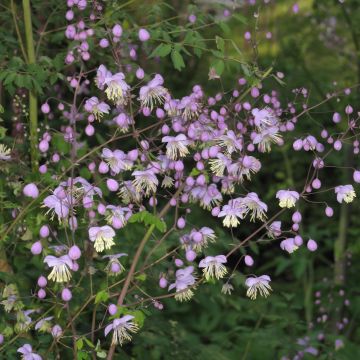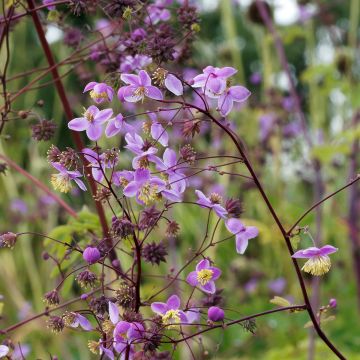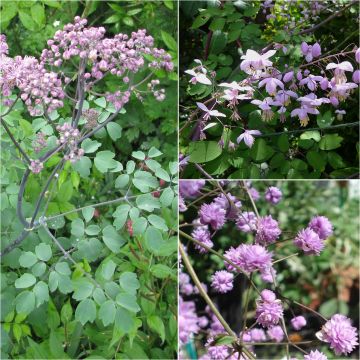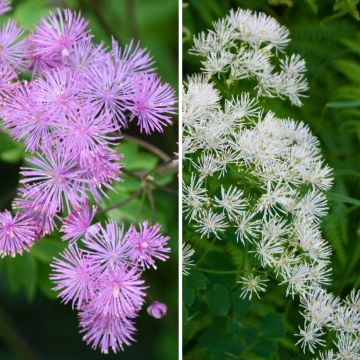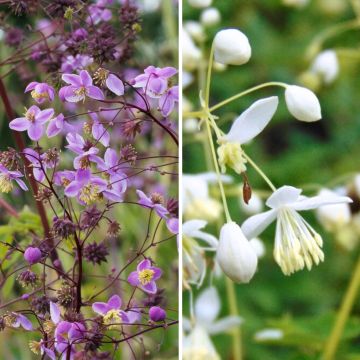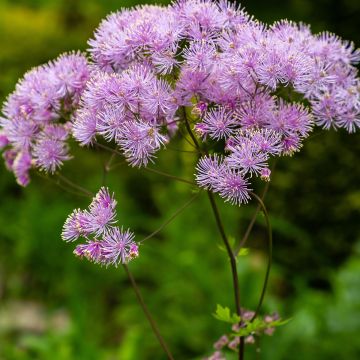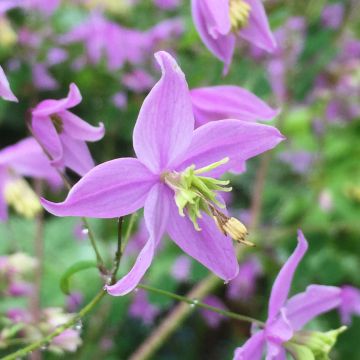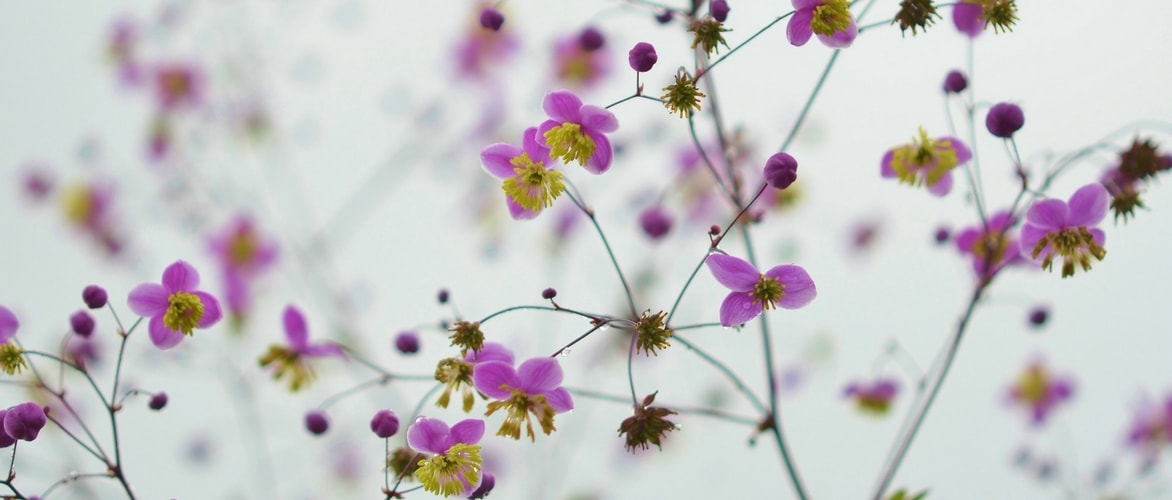
Thalictrum, Pigamon: planting, cultivation and companion planting
Contents
How to plant, grow, and companion plant thalictrum in the garden
- Floriferous and spectacular, it is an imposing yet graceful perennial resembling a giant gypsophila
- Its opulent and airy flowering in pink, lilac, yellow, or white brightens shaded corners in spring and especially in summer
- It has beautiful, lush foliage, finely cut in soft green or glaucous, similar to that of columbine
- Perfectly hardy and perennial, once well-rooted in rich, cool soil, it requires very little care
- Emblematic of soft gardens or English mixed borders, it is our favourite perennial for natural scenes!
A word from our expert
Known as Pigamon or Columbine-leaved Pigamon, the Thalictrum is a floriferous perennial with delicate, finely dissected foliage in soft green or grey-blue, remarkable for the poetry and abundance of its flowering.
Its airy and ethereal inflorescences that reach heights of over two metres for some stunning cultivars like Thalictrum delavayi ‘Splendide’ illuminate shaded areas of the garden. Resembling clouds of dishevelled stars, its tiny flowers create a mist of lilac, pink, white, or yellow from May to September, depending on the variety. The Thalictrum delavayi, the most emblematic of the Pigamons, and the Thalictrum aquilegifolium, are two remarkably floriferous species.

Thalictrum delavayi Splendide: a variety that truly lives up to its name
Imposing specimens like Thalictrum ‘Elin’ and groundcover species like Thalictrum kiushianum, the Pigamon fits into all settings. The giants of the genus will play a dazzling role as a medium or background plant, creating an evanescent mist. The diminutive species will form lush flowering carpets for fresh rockeries and walls.
Its tall, feathery silhouettes, highly prized in England, are great classics of blurred, natural gardens, adding a poetic and expressive touch to cottage gardens and mixed borders.
It is a must-have for rose gardens, providing nuances, lightness, and transparency. The Thalictrum is the ideal companion for old roses, with which it creates opulent and romantic spring and summer scenes.
Well-established under the canopy of deciduous trees, in rich, cool but well-drained soil, and sheltered from the wind, the Pigamon forms generous clumps in just a few years alongside Japanese Anemones, Bleeding Hearts, Astilbes, Astrantias, Lilies, Foxgloves, or even hardy geraniums. It creates a happy contrast when paired with less flexible plants like Hostas or ferns.
Cut, its light flower stems make for very pretty fresh or dried bouquets with a rustic spirit.
Romantic, airy, spectacular, discover the Thalictrum, this magnificent floriferous perennial that is easy to care for and brightens up the garden!
Botany
“`html
Botanical data
- Latin name Thalictrum
- Family Ranunculaceae
- Common name Meadow Rue, Delavay Meadow Rue, Columbine-leaved Meadow Rue
- Flowering May, June to July
- Height from 10 cm for dwarf species to over 2.50 m for the tallest
- Exposure partial shade, shade
- Soil type neutral to acidic (heather soil)
- Hardiness -15 °C
Thalictrum, also known as Meadow Rue, is a herbaceous perennial in the same family as buttercups: the Ranunculaceae. Native to cool, moist mountainous areas, it is most commonly found in temperate regions of the Northern Hemisphere, including America, Europe, and Asia, particularly in China and Japan. In the wild, it grows at altitude, in cool, shaded areas, by torrents, in forests, meadows, and on grassy slopes.
Vigorous, Meadow Rue can be planted throughout France, except in very windy regions and Mediterranean climates. Most prefer regions with cool, moist summers. The apparent lightness and delicacy of Thalictrum is deceptive: it is a robust perennial with ironclad health. Perfectly hardy, Meadow Rue withstands frost and tolerates negative temperatures down to -15 °C, but only for a short duration.
In Greek, Thalictrum means “to green quickly”, referring to its propensity to develop abundant foliage very rapidly.
More than 130 species of rhizomatous or tuberous perennials make up this genus. From immense specimens to groundcover species, every Thalictrum finds its place in the garden. The most emblematic of the Meadow Rues cultivated in our latitudes is the Thalictrum delavayi and Thalictrum aquilegifolium, both remarkably floriferous species. Some hybrids, like the Thalictrum ‘Elin’, are giants that can reach nearly 3 meters in height. Among the most commonly cultivated species, Thalictrum rochebrunianum is one of the most imposing. The Thalictrum actaeifolium and the Thalictrum flavum are notable for their fragrant flowers, not to mention the adorable groundcovers like the Thalictrum kiushianum that does not exceed 10 cm.
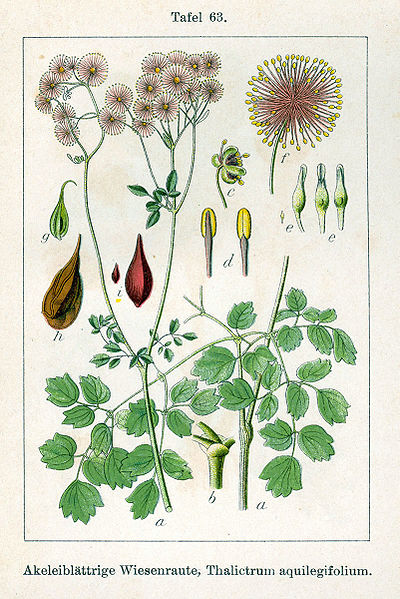
Thalictrum aquilegifolium – Botanical illustration
The large Thalictrum have an upright and airy habit, forming wide, vigorous clumps that can reach 60 cm in spread. They are perfect for planting in the middle or back of borders in semi-shaded areas, under trees, or in prairie gardens. The smaller varieties make good plants for cool rockeries.
A bit slow to establish, Meadow Rue needs about two years to mature and then express its full potential. However, it is worth the wait because, as the years go by, it becomes more beautiful. Once well-rooted, this rhizomatous perennial grows quickly to form dense clumps. Almost indestructible, it has a long lifespan.
In April, from its robust crown, very finely divided leaves and tall, slender stems emerge slowly at first, more or less ribbed, highly branched, and blue-green or purplish-brown, almost black depending on the variety.
Very quickly, as soon as the temperature warms up, it forms in just a few weeks a large, light, flowering mass made up of a cloud of small flowers.
Spectacular, the feathery flowering gives this large perennial the appearance of a giant gypsophila. From June to mid-September, flexible, very airy flower spikes can rise up to 2.50 m high for the Thalictrum ‘Elin’, bearing large panicles or loose corymbs that are highly branched and contain countless fluffy balls that open into small star-shaped flowers (1 to 3 cm). In shades of pink, yellow, lilac, pure white, or deep violet, they seem to float in the air, like arachnid constellations, attached to their very fine pedicels. Lacking petals, each flower has simple or semi-double sepals that surround clusters of stamens, sometimes so prominent that they give the flowers a fluffy pom-pom appearance reminiscent of gypsophila or mimosa.
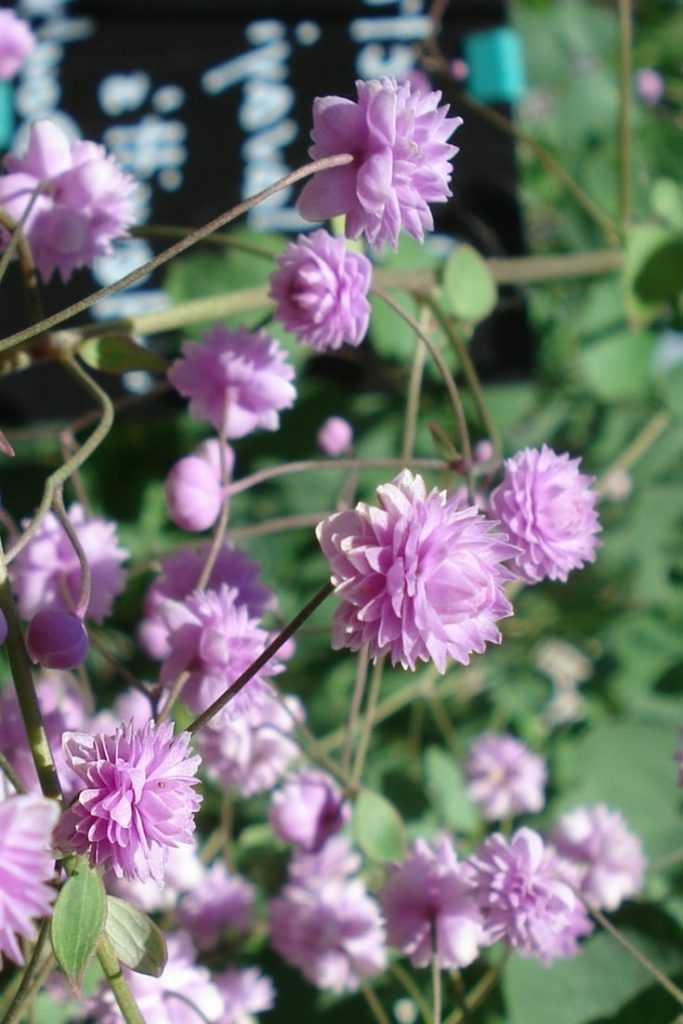
Thalictrum delavayi Hewitt’s double
The flowers are sometimes bicoloured, with white or pink sepals and contrasting purple or lilac stamens with white tips, green-touched whites, or yellows. The sepals fall more or less quickly at the beginning of flowering, leaving the clouds of star-like stamens to provide the colour. Some cultivars, such as the Thalictrum delavayi ‘Hewitt’s Double’, do not have stamens but double flowers, resembling tiny soft, velvety roses.
The flowering lasts a good month. While Thalictrum delavayi flowers from summer until late autumn, the Thalictrum aquilegifolium offers a spring flowering in May-June.
While fragrance is not the main asset of Thalictrum flowers, some species like Thalictrum flavum and Thalictrum actaeifolium are fragrant and exude a light bergamot scent. Particularly melliferous, they attract pollinating insects.
Each pollinated flower produces a small winged fruit. When planted in favourable conditions, in heavy, cool soil, Thalictrum (notably T. aquilegifolium) tends to naturalise by self-seeding spontaneously. As soon as they are mature, the brown seeds disperse, carried by the wind.
The fluffy inflorescences of Meadow Rues make lovely airy bouquets both dry and fresh: in a vase, the flowers last a good week after being cut. They are perfect for rustic and romantic bouquets, combined with roses, lilies, or umbellifers.
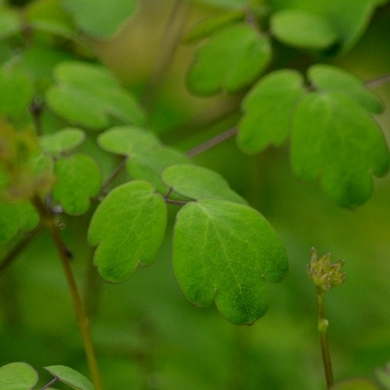
An elegant foliage reminiscent of that of Columbines
The foliage, of rare elegance, is as interesting as the flowering. Deciduous, it disappears in winter and only reappears late in spring, allowing for the association of Thalictrum with bulbous plants that will occupy the space early in the season. Finely cut and light, it resembles that of certain ferns like capillary, but even more so that of columbines: a resemblance that has earned Thalictrum aquilegifolium the nickname “Columbine-leaved Meadow Rue”. Very fine in appearance and delicate, the toothed leaves, divided into rounded and flat leaflets with 3 to 5 lobes, measure from 10 to 40 cm depending on the species. As they spread, they add a certain opulence to the plant. The foliage takes on beautiful shades of green, from lime to glaucous with a slight bluish and silvery tint.
While it resembles Gypsophila paniculata, Thalictrum prefers the cool environments of woodland edges; it enjoys bright exposures but without direct sunlight during the hottest hours. Therefore, it should be given a spot exposed to morning or evening sun, under the canopy of deciduous trees. Conversely, Thalictrum does not like too dense shade that would limit its flowering: do not place it in competition with shrubs that could deprive it of light and offer it too dry a soil in summer. It is better to grant it a sheltered spot from dry, strong winds that could dry out the foliage and flatten the tall flower spikes.
Very easy to cultivate and low-maintenance, it does require, however, a rich organic matter soil, well-drained and free of lime to flower well. While it tolerates a bit of all soil types (except very poor, dry, and stony soils), its preference typically lies with woodland soil, neutral or acidic. It enjoys light soils, even heavy ones, as long as they remain cool and sufficiently moist with good mulching during the growing season. A cool soil allows it to develop vigorously.
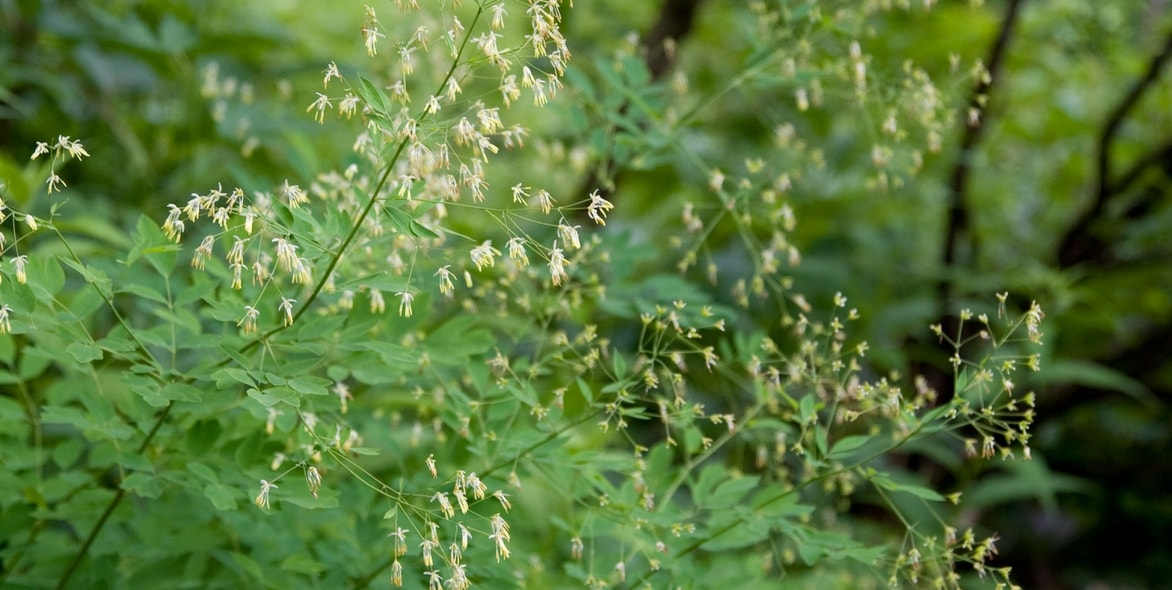
Thalictrum aquilegifolium in woodland
The immense specimens like Thalictrum ‘Elin’ are rarely used in isolation but are planted at the back of borders, associated with other vigorous perennials or shrubs that will act as supports, preventing their clumps from flopping unattractively. Groundcover species, such as Thalictrum kiushianum, are reserved for cool rockeries and flowering walls.
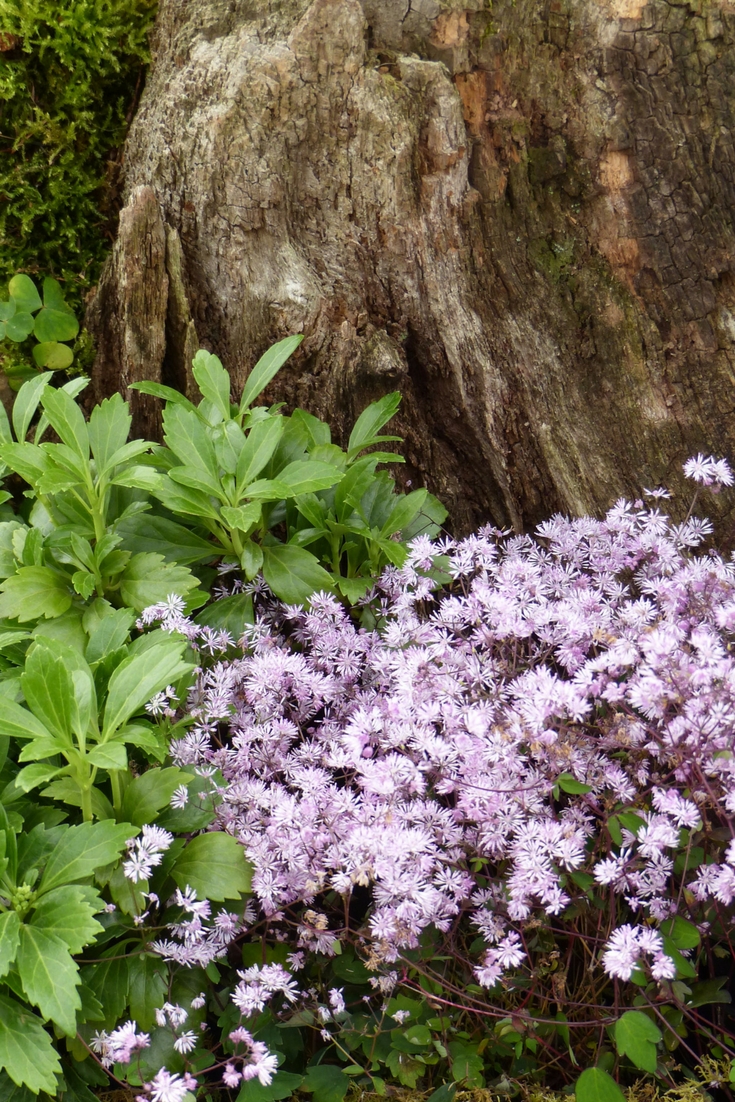
Thalictrum kiusianum and Pachysandra terminalis: a lovely combination for tree base
The specific name delavayi was given to Thalictrum in honour of Father Jean-Marie Delavay, a Christian missionary who, in the 19th century, collected one of the largest botanical collections in China for the National Museum of Natural History in Paris.
“`
Main species and varieties
The genus Thalictrum comprises around 130 species with varying sizes and flower colours. From the diminutive Thalictrum lilliputian to the giant Pigamons, there is a place for everyone in the garden. Thalictrum delavayi is the most emblematic of the Pigamons, and along with Thalictrum aquilegifolium, it ranks among the most floriferous in the genus. Both feature numerous interesting cultivars. Among the most commonly cultivated species, Thalictrum rochebrunianum is one of the most impressive. While most Pigamons are unscented, some emit a light fragrance. The tall Thalictrum make excellent backgrounds or fillers for semi-shaded areas, while dwarf Pigamons like Thalictrum kiushianum are great for cool rockeries, slowly forming a charming, floriferous carpet.

Thalictrum delavayi - Meadow-rue
- Flowering time July to September
- Height at maturity 1,70 m
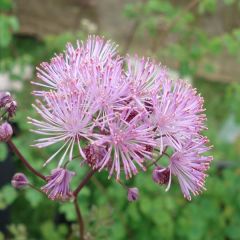
Thalictrum aquilegiifolium - Meadow-rue
- Flowering time July, August
- Height at maturity 1,20 m
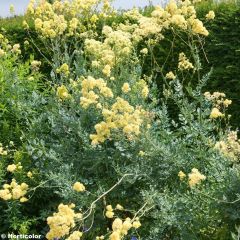
Thalictrum flavum subsp. glaucum - Meadow-rue
- Flowering time July, August
- Height at maturity 1 m
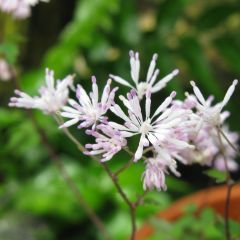
Thalictrum kiusianum - Meadow-rue
- Flowering time May to October
- Height at maturity 15 cm
Giant Pigamons:

Thalictrum Elin - Meadow-rue
- Flowering time July, August
- Height at maturity 2,50 m

Thalictrum delavayi Splendide - Meadow-rue
- Flowering time July to November
- Height at maturity 1,75 m

Thalictrum delavayi Splendide Album - Meadow-rue
- Flowering time August, September
- Height at maturity 1,50 m
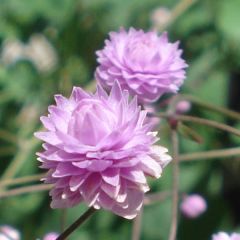
Thalictrum delavayi Hewitts double - Meadow-rue
- Flowering time July to October
- Height at maturity 1 m
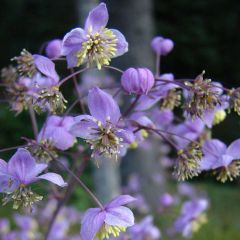
Thalictrum rochebrunianum - Meadow-rue
- Flowering time August, September
- Height at maturity 1,50 m
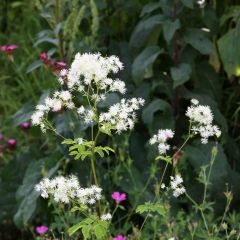
Thalictrum aquilegifolium Album - Meadow-rue
- Flowering time July, August
- Height at maturity 1,20 m
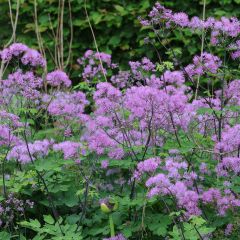
Thalictrum Black Stockings - Meadow-rue
- Flowering time July, August
- Height at maturity 1 m

Thalictrum actaeifolium Perfume Star - Meadow-rue
- Flowering time July, August
- Height at maturity 80 cm
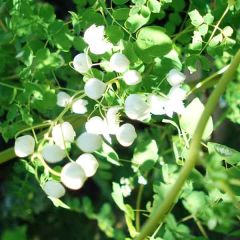
Thalictrum delavayi Album - Meadow-rue
- Flowering time August, September
- Height at maturity 1,50 m

Thalictrum delavayi Splendide - Meadow-rue
- Flowering time July to November
- Height at maturity 1,75 m

Thalictrum Elin - Meadow-rue
- Flowering time July, August
- Height at maturity 2,50 m

Thalictrum delavayi Splendide Album - Meadow-rue
- Flowering time August, September
- Height at maturity 1,50 m
Discover other Thalictrum - Meadow Rue
View all →Available in 1 sizes
Available in 2 sizes
Available in 3 sizes
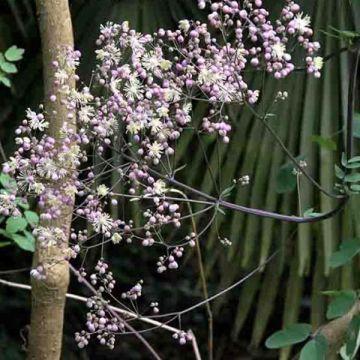
Available in 2 sizes
Available in 0 sizes
Available in 0 sizes
Available in 0 sizes
Available in 2 sizes
Available in 1 sizes
Available in 1 sizes
Planting and Care
When to Plant?
Thalictrum can be planted in spring from March to May after the frosts, or in autumn from September to November, after the heat of summer.
Where to Plant?
Despite its appearance as an easy-to-cultivate perennial, Thalictrum has some requirements: it dislikes hot, drying exposures, dry and violent winds, and competition from roots.
Vigorous, Thalictrum grows almost everywhere in France, except in dry and very windy regions and in Mediterranean climates, as it fears scorching sun. The Pigamon will tolerate summer heat in temperate regions, provided the soil remains consistently moist and cool.
With excellent hardiness, it withstands frost and can tolerate temperatures below -15 °C but only for a short duration.
Thalictrum thrives in a rather shady and well-cleared spot, sheltered from strong winds: it will flourish in partial shade, out of direct sunlight, under deciduous trees that provide beneficial coolness. It prefers an open situation, which encourages it to reach its full height. Too dense shadows would limit its flowering: do not place it in competition with bushes that would deprive it of light. It also dislikes root competition: ensure it has space!
It has a formidable enemy: the wind. A too windy location poses a threat to these tall perennials. These lofty, feathery silhouettes are graceful as long as they stand upright! They should be given a spot sheltered from dry and violent winds that could dry out the foliage and cause the clumps to flop.
While it integrates into all settings, it truly shines as a middle or background plant in borders. The tallest varieties (Thalictrum ‘Elin’, Thalictrum delavayi ‘Splendide’, Thalictrum rochebrudianum) should be planted at the back of borders, providing a vaporous relief and striking verticality. Planting them lower down will allow full enjoyment of their flowering.
Groundcover species like Thalictrum kiusianum, are perfect for shady rockeries and cool flowerbeds.
How to Plant Thalictrum?
Thalictrum is slow to establish, but once well-rooted after two years, it becomes very perennial. The secret to cultivating this vigorous perennial lies in the planting.
- The soil should be cool to moist, but well-drained (excess water in winter can be fatal), slightly acidic, and rich in organic matter. It dislikes dry, poor soils where it will never be lush. It prefers rather heavy to light soils kept sufficiently moist with good mulch during the growing season.
- It tolerates slightly clayey soils but fears overly heavy soils. Don’t hesitate to mix well-rotted compost into the soil, about 5 to 10 L, at the bottom of each hole before placing the root ball.
- Keep the soil cool at the base of the Thalictrum with mulch, especially during summer: this guarantees prolonged flowering.
- Once the young plants are established, they should not be disturbed. It is only in the second year that they will begin to bulk up and flower properly.
- If you love the delicately cut and lush foliage of Thalictrum, so do gastropods! As the foliage disappears in winter, it is wise to mark the location of the plants with a small stake, to monitor snails and slugs in spring that devour the young shoots. Fern manure can help combat their attacks.
- Plant 2 to 5 plants per m², spaced at least 50 cm apart. Thalictrum dislikes root competition: avoid planting too close to bushes. It is a very airy plant that remains transparent; it is better to plant in numbers for a beautiful effect in a border.
- For giant pigamons, staking is sometimes essential, especially if they are planted in isolation. Keep this in mind: it will prevent the stems from breaking at the slightest gust of wind: a strong gust and your border will look like a battlefield after a storm! Another solution to prevent its flower spikes from collapsing in the middle of a border is to plant the Pigamon with other plants and shrubs, which it can lean on.
- A living mulch made of groundcovers like Pachysandra, periwinkles, or bugle will keep the base cool.
- Water regularly during the first summer to encourage rooting.
Maintenance
Once established in ideal growing conditions, Thalictrum is not demanding. Very resistant to diseases, it requires little care and proves to be a beautiful, trouble-free perennial with robust health! As long as the soil remains cool and sufficiently nourishing.
- Each winter, spread a good layer of fallen leaves; as it decomposes, this plant mulch will turn into humus.
- Fertilise each spring with compost to improve drainage in winter and facilitate root development.
- Stake large specimens that are very sensitive to wind if necessary.
- During dry and hot periods, mulch and water very regularly in the evening. It tolerates summer heat, provided watering is daily.
- Pruning is not necessary: simply remove faded flowers regularly to prolong flowering and prevent excessive self-seeding.
- At the end of autumn, cut back the deflowered stems by half.
- Avoid cutting the plant back to the ground in autumn: as its foliage does not reappear until spring, you risk forgetting it!
Possible Diseases
Pigamons have only one known enemy: gastropods. Easy to grow, it does not suffer from diseases, except perhaps powdery mildew during dry spells. Watch for slug attacks at the start of the growing season!
Read also
Fluffy plantsSowing
Dividing clumps is possible but tricky, as the risk of damaging the root is considerable. We do not recommend it, especially since Thalictrum is very easy to sow.
Indeed, sowing is the simplest method: this perennial is very easy to grow from seeds. While some varieties, such as Thalictrum delavayi ‘Hewitt’s Double’, which is sterile, as well as hybrids, do not propagate by sowing, most meadow rue produce seeds that germinate easily. Sowing should be done in autumn with fresh seeds from the year, harvested as soon as they turn brown, before they dry out, or with seeds sold in packets.
- Sow immediately under a cold frame in a mix of potting soil and garden soil. This cold treatment will encourage germination.
- Plant the seeds 6 mm deep.
- Expect germination in two to three months; they will sprout in spring.
- Transplant when the seedlings have hardened off, reaching 5 cm in height.
- Protect young plants from slugs at the time of planting.
Associate Thalictrum
Reliable choice for light shade borders, Thalictrum is perfect for brightening up cool areas and playing with shades and gradients. With its tall, airy silhouette, delicate and light foliage, and pastel inflorescences, it transforms a simple perennial border into a poetic mixed border. It is the ideal companion for old roses, creating opulent and romantic spring and summer scenes together. It embodies the charm of English cottages and dreamy gardens with a pastoral or vicarage feel, adding height, exuberance, and lightness. It is a must-have in rose gardens.
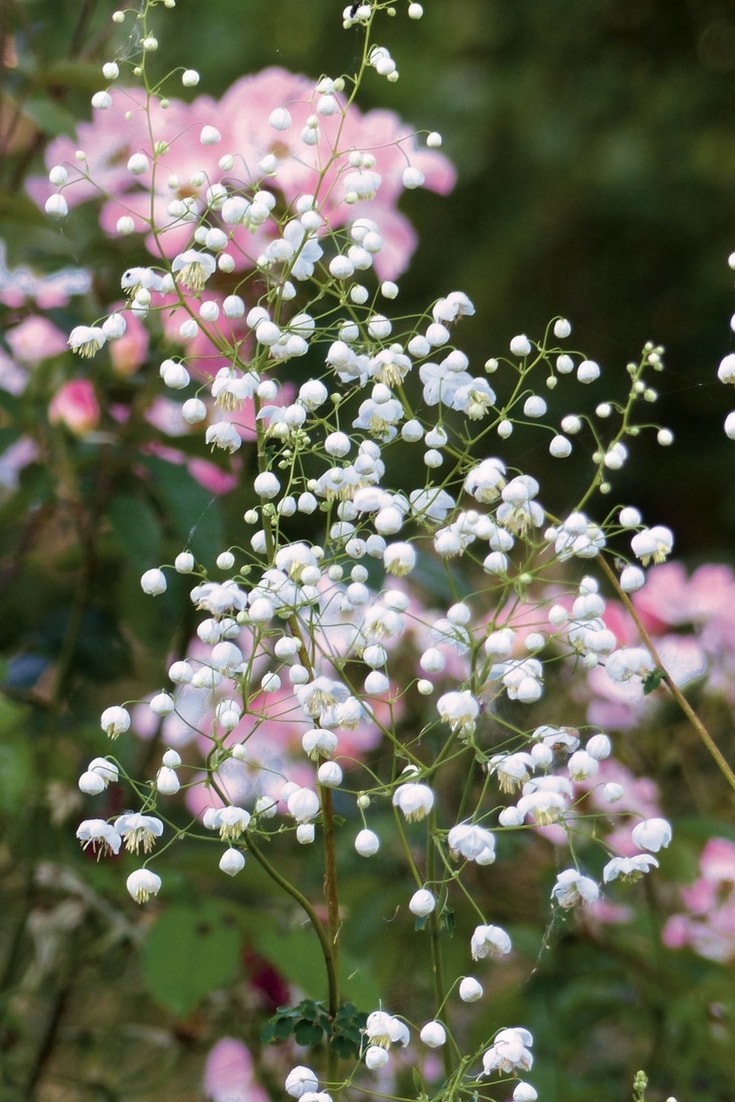
Thalictrum splendide White against a backdrop of roses: a true marvel for romantic gardens
It thrives in a community alongside vigorous perennials that will precede or follow its flowering, such as Japanese Anemones, Bleeding Hearts, Aconite, Columbines, Astrantias, Foxgloves, or even hardy geraniums.
Whether tall or groundcover, Thalictrum fits into any setting, and can serve as a dazzling mid- or background plant creating an ethereal mist or as a flowering mossy carpet for cool rockeries.
It creates a happy contrast when paired with less flexible plants like Hostas or ferns and works wonderfully with heather soil shrubs like Hydrangeas, with which it forms lush borders.
You can also create a beautiful combination with Lilies, Astilbes, or even grasses or Uvularia grandiflora. Thalictrum, flowering in late summer and early autumn, pairs beautifully with Asters, accompanying their bloom. To maintain freshness at the base of Thalictrum, consider groundcovers like Sweet Woodruff, a carpet of Periwinkles, or Bugle in soft pink.
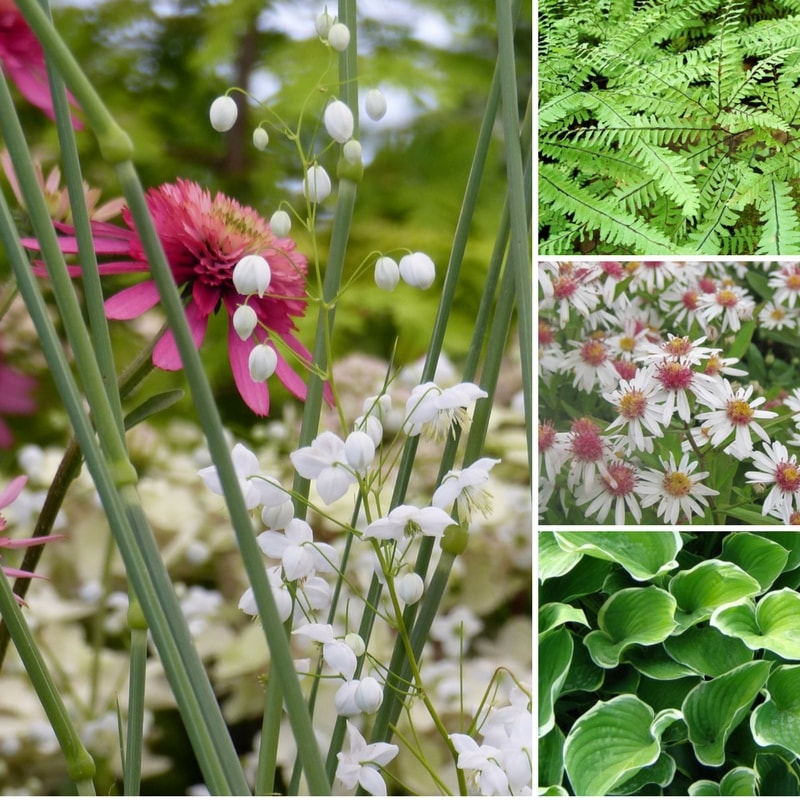
Another example of association: Thalictrum delavayi Splendide Album with Echinacea Catharina, Aster lateriflorus Chloe, Hosta Sagae, and Adiantum aleuticum Imbricatum
Need more inspiration? Discover our advice sheet: “Thalictrum, Pigamon: 8 beautiful pairing ideas”.
Useful resources
- Collect Pigamon seeds! This perennial is one of the easiest to sow!
- Planting perennials well is easy with our advice sheet
- Which plants to associate with Thalictrum? Pierre, our horticultural engineer, shares his valuable insights.
- Also discover our advice sheet on slow-to-establish plants
Frequently asked questions
-
Planted two years ago, my Pigamon isn't growing, is that normal?
Yes, don't worry. The Pigamon needs about two years to settle in properly and reach its full potential. It will struggle in the first few years. However, it is worth the wait because, as the years go by, it becomes more beautiful. Once well-rooted, this rhizomatous perennial grows quickly to form dense clumps. Your patience will be rewarded: once established, it is virtually indestructible!
-
Can Thalictrum be planted in isolation?
Yes, it is possible, but the effect will be less striking than with a mass planting. It is when associated with other perennials that its beauty is revealed. The large specimens are rarely used alone; they are preferably planted in the middle or back of a border, alongside other perennials with strong growth such as Hostas or Japanese Anemones, or even shrubs like Hydrangeas, which will provide support, preventing their clumps from flopping unattractively.
-
I have a shady rockery; which Thalictrum should I choose to flower it?
The genus Thalictrum includes giant specimens as well as groundcover species, which are somewhat less known but remarkably floriferous. Thalictrum kiushianum will be stunning in cool rockeries, shaded borders, and flowering walls. Year after year, it will form a charming little carpet that is very floriferous, offering a profusion of small, soft pink-mauve pompom flowers from April to June, and again in September.
-
Can I try growing the Pigamon in my garden, which is quite exposed to the wind?
The Pigamon has a formidable enemy: the wind! An overly exposed situation poses a threat to these tall perennials. Reserve a spot sheltered from the dry and violent winds that could dry out the foliage and cause the clumps to flop. Another precaution, especially for giant varieties, is staking. This is essential, particularly if, like in your garden, they are exposed to the wind. Otherwise, the stems could break at the slightest gust, and your flowerbed would resemble a battlefield after a storm! To prevent this, we also recommend planting Thalictrum alongside other perennial plants or bushes, which it can lean on for support.
- Subscribe!
- Contents
































